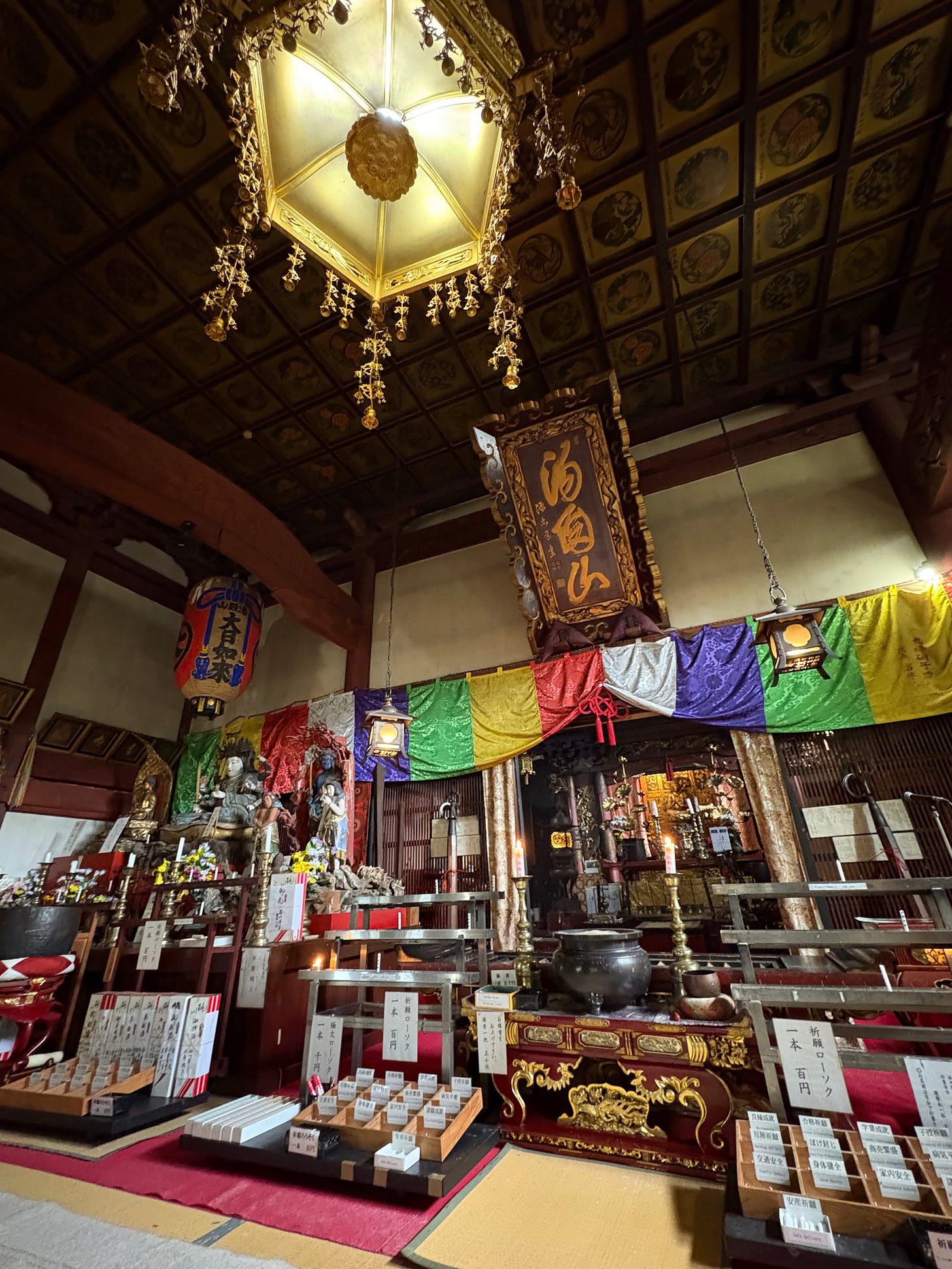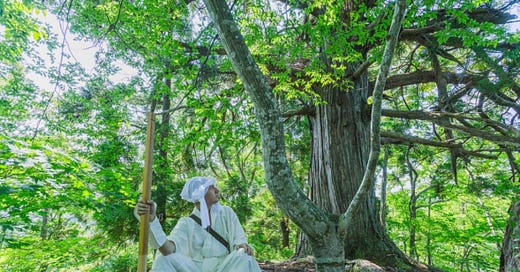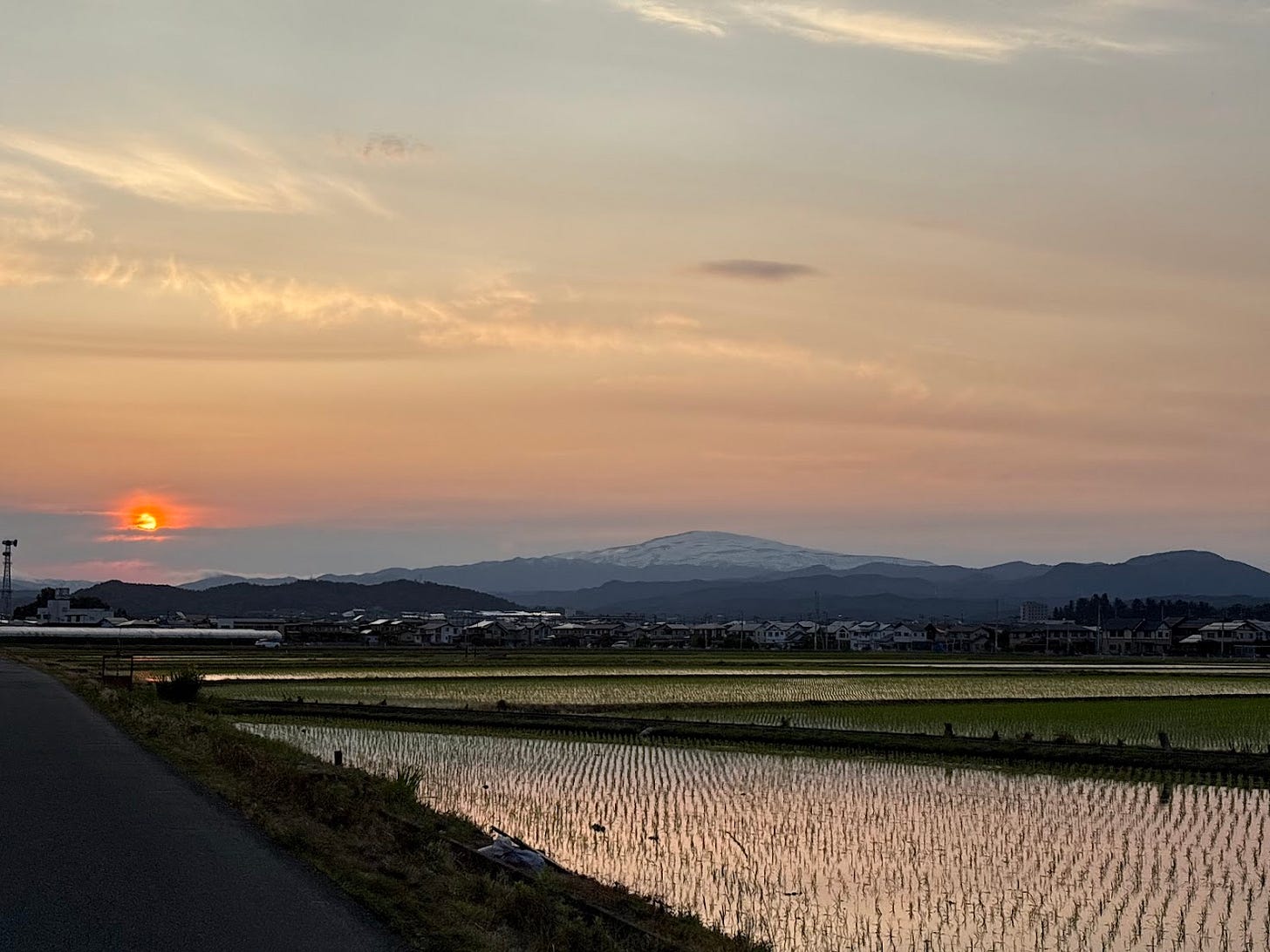Maiko, Mountain Monks, and Jellyfish
Discovering the Unexpected Wonders of Yamagata's Shonai Plain
Yamagata Prefecture, located in Northern Japan, has innumerable beautiful spots to visit. It is not a popular tourist destination, but it is becoming more known, especially for Yamadera (a mountain temple in Yamagata City), Ginzan Onsen, and the ski resort of Mount Zao. All these sites are located in the Murayama Valley of Yamagata, accessible from Tokyo by the Yamagata Shinkansen. I am writing this article to highlight a different region of Yamagata Prefecture.
The Shonai Plain is located on the west coast, bordering the Sea of Japan. It is surrounded by mountains to the north, east, and south. It is accessible from trains that extend south from Akita and north from Niigata. There are both flights and night buses that connect Shonai to Tokyo. It is accessible via driving or bus from other areas of Yamagata. Lastly, Sakata is becoming a popular stop for cruise ships too.
The Shonai Plain is rich in agricultural resources. It is known for its high-quality rice and sake. The port city of Sakata was actually the richest city in Japan during the Edo period due to the high quality of its merchandise and its location as a trade hub. Other than the city of Sakata, the Shonai Plain is also home to the city of Tsuruoka, a UNESCO Creative City of Gastronomy. The area also has three towns named Mikawa, Shonai, and Yuza.
Mount Haguro (羽黒山)
This mountain is one of the three sacred mountains of Yamagata, the Dewasanzan (出羽三山). The three sacred mountains of Yamagata, the Dewa Sanzan, which are also the symbol of Yamagata's flag, include Mount Haguro, Mount Gassan, and Mount Yudono. These are all important important sites for both Shintoism and Buddhism, but it is an especially significant site for the yamabushi (山伏). Yamabushi translates to English as “mountain ascetics.” I do not know much about this type of worship, but the yamabushi see the mountain as a spiritual entity, and certain rites occur here.
For religious people, this mountain is a sacred site, but it is also accessible to laymen tourists such as myself. I started at the bottom of the mountain. At the start of the hike, I first passed through a grand gate and then descended the stairs. I soon passed shrines, a beautiful bridge, and a waterfall before arriving at a sacred pagoda. While these were all beautiful sites to explore, the journey to the summit was only just beginning. The natural beauty of Mount Haguro is evident through its long hike through the green forests and towering trees. The route contains a total of 2,446 steps.
While it was a bit of a struggle since I am not a seasoned hiker, it was worth it for the journey to the top. The temple at the summit is breathtaking in its detail and scale. I was truly amazed by its vivid color and towering thatched roof.
If you want to do the hike, it is definitely welcome to all abilities since it is all stairs instead of rugged mountain paths. For the steeper parts, just take it slow. However, if you are not a fan of hiking or are not able to, it is possible to visit the summit by driving your car there.
Mount Gassan (月山)
Mount Gassan is another sacred mountain in Yamagata. It hovers above the prefecture, and looking at it day after day is one of my favorite scenes. My favorite memory here was my gorgeous autumn hike.
It is covered in snow for much of the year. In fact, it is open for “summer skiing.” While ski mountains normally close in April, Gassan actually opens in April. The snow walls leading up to the ski resort are quite impressive. Skiing usually lasts until June, and in some years, you can even ski until July!
The slopes of Gassan are also home to a special winter festival, Shizu Onsen's Yuki Hatago Akari Festival. Because Gassan gets such an impressive amount of snow, they are actually able to carve buildings out of snow, which are able to be explored during this winter festival. You can read more about this festival and other winter festivals in Yamagata below.
Kamo Aquarium (加茂水族館)
Located in Tsuruoka along the beautiful coast, Kamo Aquarium has the world's best collection of jellyfish. There are over 85 species on display. I was quite impressed and learned a lot about species I had never seen before. The variety and uniqueness of the species was fascinating. For instance, some species are very small, and others are super long. Some glow in the dark, others vibrate with rainbow lights, and others appear to have neon colors. The highlight of the aquarium is its large jellyfish tank with innumerable neon blue jellyfish floating around. I highly recommend checking it out.
On top of jellyfish, the aquarium also has other exhibits, such as seals, sea lions, and large tanks full of fish. There is also a unique ice cream to try - jellyfish ice cream! The restaurant also serves jellyfish ramen and other seafood dishes. I definitely recommend a visit here.
Jūroku Rakan Iwa (十六羅漢岩)
As an American, I can weakly compare this site to Mount Rushmore, albeit it is much smaller in scale. Located along the rocky coastline of Yuza is an area with 22 carvings. There are 16 carvings of the 16 Arhats, which are high-ranking figures from Buddhism who have achieved nirvana. Other than the 16 Arhats, there are also representations of Shakyamuni, Manjusri, Fugen and his consort, Avalokitesvara, and the Sarira. I have to admit that these names do not mean much to me, but this site is a special place to visit to contemplate and take in the view.
These carvings were created over 150 years ago by a local Buddhist monk who created these sculptures to mourn missing fishermen and pray for the safety of those in the sea. From this coast, you can stare out into the ocean while trying to find all 22 carvings hidden amongst the volcanic rock. I have yet to find them all.
The Living Buddhas (即神仏)
This area of Japan has a unique Buddhist tradition of Sokushinbutsu (即身仏). While a Westerner may define them as “mummies,” in Buddhist tradition, they are referred to as Living Buddhas. This practice differs from the traditions of Egypt, for instance. These individuals are not corpses, but rather physical bodies representing eternal dedication to Buddhist traditions and beliefs. The time that these individuals “died” is redefined as the time they became a Buddha. Buddhism believes in a never-ending cycle of death and rebirth, and going through this intense religious rite was seen as a way to expedite the process of becoming a Buddha. Their physical bodies remaining for centuries after their death is also a testament to their fortitude and religious belief for viewers.


These people, hundreds of years ago, went through a process of self-mummification. While I am not an expert, I did gain an interest in the topic and visited multiple temples that feature these self-mummified deities in this area of Yamagata. For a few years before death, these individuals ate a strict diet that included mountain nuts, seeds, pine needles, etc. The diet was strict to avoid the types of food that cause the body to decompose upon death.
If you visit the Shonai area these days, you can visit temples that feature Sokushinbutsu. Yamagata actually is the prefecture of Japan with the most Living Buddhas in Japan as it has 8 of the roughly 12 that exist in Japan. You can pray in front of these spirtual bodies. They look the same as they did hundreds of years ago when they left this mortal world. I have seen Living Buddhas at both Dainichibo Temple in Tsuruoka and Kaikoji Temple in Sakata. The latter is special because it is the only temple that has two Sokushinbutsu together.
These bodies are wrapped in gorgeous orange cloaks and robes, which are changed every decade. The used clothing is then cut into pieces and sold as onamori, which are good luck charms that are sold at temples and shrines in Japan.
For more details about the specifics of this Buddhist rite, please refer to other sources such as https://donnykimball.com/sokushinbutsu-55261787a9af. If you do come to Shonai, definitely check out the temples that feature Sokushinbutsu and be inspired by the mental fortitude and religious dedication it took for their physical body to be in front of you centuries later.
Tobishima (飛島)
The only inhabited island of Yamagata, Tobishima, is located in the Sea of Japan, around 40 kilometers from the coast. It is by no means a major tourist destination, but it is a beautiful place for slow travel. The island is accessible by a daily ferry from Sakata harbor. Please read more about it in the blog post below. I have fond memories here.
The Island of Tobishima: A Slow Travel Gem
Japan is an island nation of more than 14,000 islands. Only 430 of them are inhabited. The Northeastern prefecture of Yamagata has just one of them. Its name is Tobishima (飛島). In a country where tourists and citizens complain about over-tourism, I am highlighting a place that has not been experiencing over-tourism. When I went, it appeared that my frie…
Homma Museum of Art (本間美術館)
The Homma Family used to be one of the richest families in Japan during the Edo Period. They got rich through being maritime merchants and moneylending. While the actual art museum was quite small, the neighboring villa and garden were extraordinary examples of Japanese landscaping and architecture. I recommend a visit to this museum to appreciate the beautiful craftsmanship of the museum items, the villa's architecture, and the seasonal beauty of the garden.
The Maiko of Somaro (相馬樓の舞子)
A visit to Sakata would be incomplete without experiencing the charm of the Somaro Maiko Teahouse. Here, you can enjoy a daily performance by the city's maiko (geishas in training). While many travelers hope for a fleeting glimpse of a geisha in the crowded streets of Kyoto, Sakata offers a unique opportunity for a much more personal and affordable encounter. For just 2,500 yen, you are welcomed into a gorgeous, historic teahouse that harkens back to Sakata's golden age. The maiko's music and dance are captivating, and their stunning outfits and makeup are a sight to behold. Best of all, after the performance, you even have the chance to take a photo with them, creating a perfect memory of this special cultural experience.
This was only a brief introduction to this area of Japan. There are many more natural wonders to see too. For more information about this area of Japan, I recommend reading Tim Bunting's posts. He is a New Zealander living in this part of Yamagata and writes about the Yamabushi tradition. Check him out here
Thank you for reading!
















Wonders of never knew about. Thanks for sharing!
Nice. Yamagata encyclopaedia.